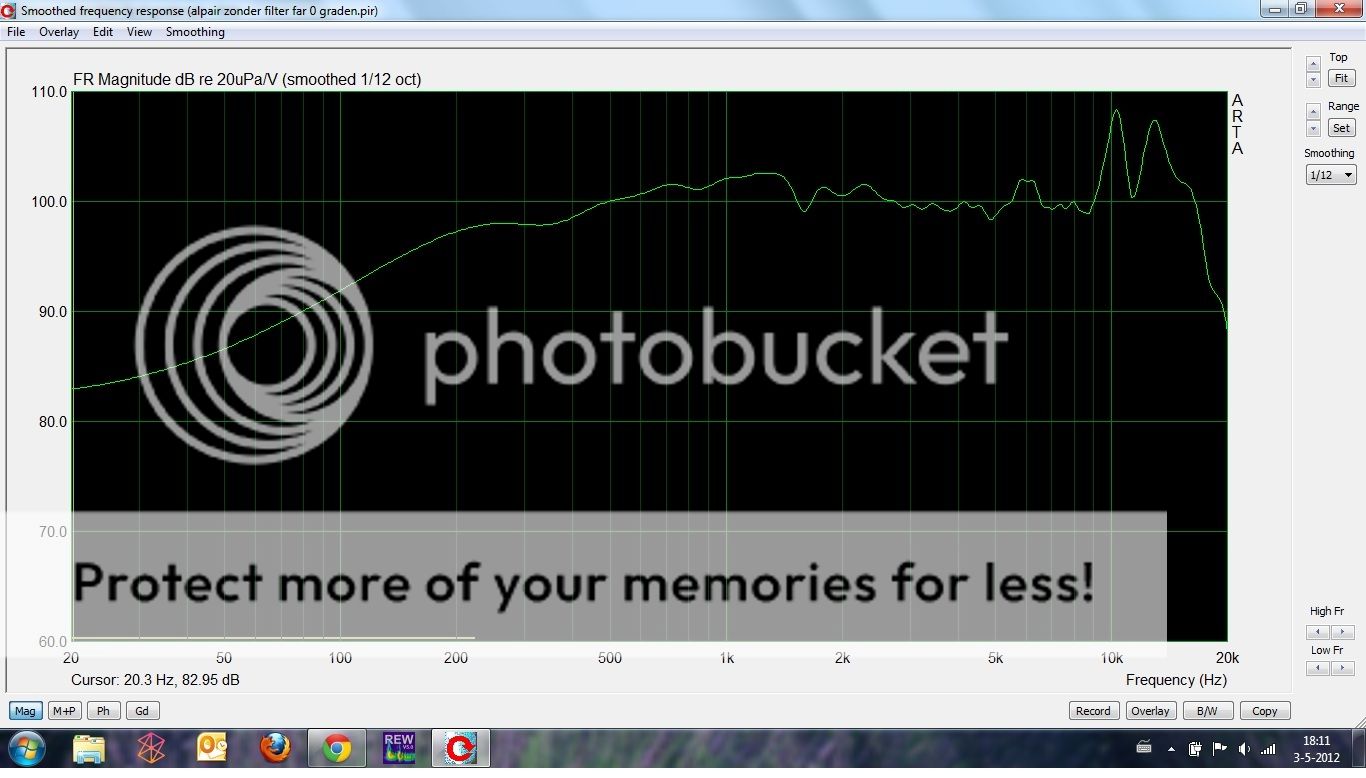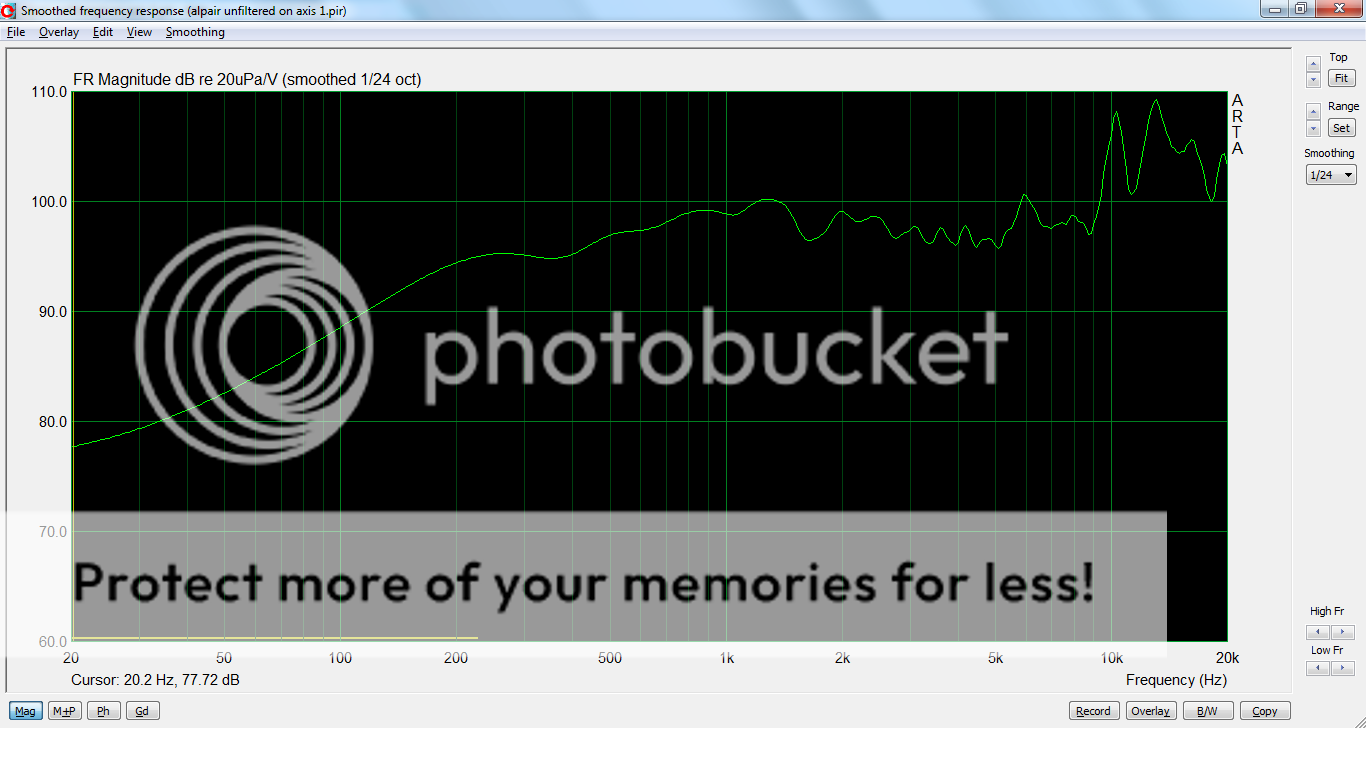You could probably eliminate the shelf by level adjustment between the drivers??
Did you ever measure these? I helped a guy on another forum with his A7 FAST. He measured the A7 with an LR4 at 300hz high pass. I didn't do the measurement, but I processed it. The gate is 2.7ms because he measured to close to the floor, so the high pass isn't well defined in the measurements. He got this:
An externally hosted image should be here but it was not working when we last tested it.
That was in the cab. I'm surprised by the baffle step region. He may have done something wrong there. But it leaves me thinking your 5db shelf might be aggressive.
These must make great bassAre you using the minidsp?
Actually, those measurements mirror mine quite nicely:

I'm using the Hypex AS2.100. These have a built in DSP.
Last edited:
Yes, there are a lot of similarities there. Nice. Your gate is much lower which is nice. That is with the filter? Your 6khz break up is not as bad, unless that is a filtered response.
Nice stuff! Thanks for sharing your measurement. Could you share your notch Fc, Q, and level on your 6khz break up? I got 6100hz, 5.0, and -2.5db. But these aren't my speakers so I can't hear the result. Are you going to do anything about >10khz? I figure it's probably not worth while. It's a funny shape, even with DSP.
Nice stuff! Thanks for sharing your measurement. Could you share your notch Fc, Q, and level on your 6khz break up? I got 6100hz, 5.0, and -2.5db. But these aren't my speakers so I can't hear the result. Are you going to do anything about >10khz? I figure it's probably not worth while. It's a funny shape, even with DSP.
Yes, there are a lot of similarities there. Nice. Your gate is much lower which is nice. That is with the filter? Your 6khz break up is not as bad, unless that is a filtered response.
Nice stuff! Thanks for sharing your measurement. Could you share your notch Fc, Q, and level on your 6khz break up? I got 6100hz, 5.0, and -2.5db. But these aren't my speakers so I can't hear the result. Are you going to do anything about >10khz? I figure it's probably not worth while. It's a funny shape, even with DSP.
Hi Tux, no this is the unfiltered measurement. I can get a nice free space of about 140cm around the driver in the living room, so the gate could be as big as 4.5ms. The picture I posted is with 1/12 smoothing though, not sure what settings were in the pic you posted? (although at 1/24 smoothing the 6k notch does not get worse)
My 6K notch is 6011hz, Q5.5, -2.5db. Pretty close eh? In fact I did notch the 10k as well, but not very aggressively: 10141, Q8, -2.5db.
Last edited:
Hi Swifty,Placing the woofer on the side has the obvious advantage of being able to use a large woofer without compromising on baffle width and therefore imaging. Right now I am making nice progress of dialling these in. The crossover is done via the DSP of the AS2.100 units. I am crossing over at 250 hz, LR4. I added a 5 db low shelf with a centre frequency of 595 hz. The woofer has a LT with a pole Q of 0.5 and a pole freq. of 27 hz.
While I will likely slightly modify things here and there, this already sounds amazing.
Great build !
Can you or somebody please explain why imaging should be better with a narrow baffle ?
Is this due to the diffraction effects from the edge of the baffle ? If this is so then a felt ring around the wideranger should completely eliminate the diffraction effect of a wide baffle. A wider baffle will also allow a more suitable baffle step starting at a lower frequency, eliminating need for BSC filter, reducing filter components in the signal path.
Or is there another reason for better imaging, if at all, from a narrower baffle ?
Hi Swifty,
Great build !
Can you or somebody please explain why imaging should be better with a narrow baffle ?
Is this due to the diffraction effects from the edge of the baffle ? If this is so then a felt ring around the wideranger should completely eliminate the diffraction effect of a wide baffle. A wider baffle will also allow a more suitable baffle step starting at a lower frequency, eliminating need for BSC filter, reducing filter components in the signal path.
Or is there another reason for better imaging, if at all, from a narrower baffle ?
Diffraction effects play a big role , yes. Narrow baffles also have better dispersion characteristics (less beaming so to speak), which aids imaging performance.
Thanks for replying Swifty.
I agree with you.....and believe this is ONLY due to diffraction effects. AFAIK beaming is related to the driver diameter and not the Baffle width. Infact I discussed with Martin about the baffle width causing beaming. As per his directions I simulated the angular response on his MathCAD sheets and did not observe any difference in polar response by varying the baffle width.
Somewhere I read that it is the more spherical wavefront launch from a narrow baffle that best explains the disappearing act of small baffles.
Still don't know the REAL physics behind this. Hope somebody can nail this issue as an equation !!
I agree with you.....and believe this is ONLY due to diffraction effects. AFAIK beaming is related to the driver diameter and not the Baffle width. Infact I discussed with Martin about the baffle width causing beaming. As per his directions I simulated the angular response on his MathCAD sheets and did not observe any difference in polar response by varying the baffle width.
Somewhere I read that it is the more spherical wavefront launch from a narrow baffle that best explains the disappearing act of small baffles.
Still don't know the REAL physics behind this. Hope somebody can nail this issue as an equation !!
Here's an update on the filtering:
Last week it became very apparent that there was quite a dramatic change for the worse in sound quality. Especially the region below 100 hz was becoming way too pronounced and boomy. It appears the L26ROY drivers were loosening up, resulting in too much bass. I re-measured the response and indeed, the bass region was playing about 2db too loud.
The measurements also showed I gave the Alpairs too much of a baffle step compenstaion (you're reading this Tux? You were right all along ), giving the respons too much emphasis on the 200-500hz region. Unfortunately I only saved the Alpair measurement. here are both the unfiltered measurement and the measurement of the filtered driver
), giving the respons too much emphasis on the 200-500hz region. Unfortunately I only saved the Alpair measurement. here are both the unfiltered measurement and the measurement of the filtered driver
unfiltered:

You can see the elevated response between 2500 and 500 hz. I did a Q=1 cut centeringon 1200hz with a -1.3db gain to get this region level with the 3000-10000hz region. I nothed the 6Khz bump and nothed the 10.000 hz region slightly as well I changed the 10k notch to Q=8, -2db gain. I changed nothing above 10.000hz. I only needed to low-shelve the region between 200-600hz to compensate for the baffle step. I ended up settling on these parameters: center freq. 455hz, Q=0.71, 1.7db gain.
The resulting response looks like this:

I used REW to get an idea of the problem frequencies in the 20-100hz region. I notched at 30 and 60 hz (Q=8, -3 and 4 db respectively), and reduced the output in the 70-100hz region slightly.
Not shown in the plots is the final adjstment I made a bit later: I boosted the 1630hz cone edge difraction dip by 2.8db @ Q=7. I did not expect this to work out well but it did.
The resulting performance is very, very good to my ears. I notice the urge to keep tweaking is gone. Always a good sign .
.
Last week it became very apparent that there was quite a dramatic change for the worse in sound quality. Especially the region below 100 hz was becoming way too pronounced and boomy. It appears the L26ROY drivers were loosening up, resulting in too much bass. I re-measured the response and indeed, the bass region was playing about 2db too loud.
The measurements also showed I gave the Alpairs too much of a baffle step compenstaion (you're reading this Tux? You were right all along
unfiltered:

You can see the elevated response between 2500 and 500 hz. I did a Q=1 cut centeringon 1200hz with a -1.3db gain to get this region level with the 3000-10000hz region. I nothed the 6Khz bump and nothed the 10.000 hz region slightly as well I changed the 10k notch to Q=8, -2db gain. I changed nothing above 10.000hz. I only needed to low-shelve the region between 200-600hz to compensate for the baffle step. I ended up settling on these parameters: center freq. 455hz, Q=0.71, 1.7db gain.
The resulting response looks like this:

I used REW to get an idea of the problem frequencies in the 20-100hz region. I notched at 30 and 60 hz (Q=8, -3 and 4 db respectively), and reduced the output in the 70-100hz region slightly.
Not shown in the plots is the final adjstment I made a bit later: I boosted the 1630hz cone edge difraction dip by 2.8db @ Q=7. I did not expect this to work out well but it did.
The resulting performance is very, very good to my ears. I notice the urge to keep tweaking is gone. Always a good sign
I notice the urge to keep tweaking is gone. Always a good sign.
But for how long?
But for how long?
Cool stuff. I too am surprised the 1630hz diffraction loss was audible, but that's why it's worth trying anything.
Again, great project. Keep us updated of any changes.
Yep, it surprised me as well. It's voices where I notice it most. Hard to describe what I'm perceiving as improvement, but it's there.
although you may already have planed it, i have the following suggestions for you:
1) change the position between the two speakers so the bass drivers positioned at the outside area.
2) use some spikes to lift the speakers from the wooden floor.
I love your design and you are an artist.
1) change the position between the two speakers so the bass drivers positioned at the outside area.
2) use some spikes to lift the speakers from the wooden floor.
I love your design and you are an artist.
although you may already have planed it, i have the following suggestions for you:
1) change the position between the two speakers so the bass drivers positioned at the outside area.
2) use some spikes to lift the speakers from the wooden floor.
I love your design and you are an artist.
Thanks!

About reversing the placement: Yes, this will definately happen at some point in the future but right now I am enjoying them too much so I will leave well enough alone for now.
I will make nich feet for the speakers, don't worry
- Status
- This old topic is closed. If you want to reopen this topic, contact a moderator using the "Report Post" button.
- Home
- Loudspeakers
- Full Range
- WAW / FAST build with Alpair 7.3 and Seas L26ROY and Hypex AS2.100